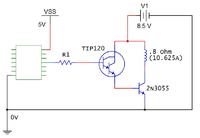cgchas
Member level 3
I am considering the suitability of some components for driving a high current load from an IC chip.
The output of the IC is 5V with a maximum current of 25mA.
Description of the driven load:
Supply Voltage: 8.5V
Load Resistance: .8 Ohms
Load Current: 10.625A
The driver components I am considering are TIP120 Darlington Transistor driving a 2N3055 Power Transistor. (image attached)
I am still learning how to calculate all of this so if possible I would like some help looking over my calculations.
Something I am not sure of is how to properly apply the datasheet information for Collector-Emitter Saturation Voltage for the TIP120. (see below)
My goal is to use the drivers as switches that will ultimately be pulsed so I want the base currents to be correct to assure saturation. For now, let's
assume no pulsing.
2N3055 Power Transistor
max collector current: 15A
max base current: 7A
min hFE: 5
base current for saturation with 15A at collector: 15/5 = 3A
collector current for driving the load: 10.625A
base current for saturation: 10.625/5 = 2.125A
TIP120 Darlington Transistor
max collector current: 5A
max base current: 120mA
minimum hFE at saturation: 250
base current for saturation with 5A at collector: 5/250 = 20mA
assuming collector current for driving the 2N3055: 2.125A
base current for saturation: 2.125/250 = 8.5mA
assuming collector current for driving the 2N3055: 3A
base current for saturation: 3/250 = 12mA
R1 (IC output to TIP120 base)
TIP120 saturation voltage at 3A: 2V
for 8.5mA base: R1 = (5v - 2V) / .0085 = 352.94 Ohms
for 12mA base: R1 = (5v - 2V) / .012 = 250 Ohms
I treated the 2V saturation voltage as a voltage drop off the IC output. Was I correct to do this?
Please advise regarding any of my assumptions.
Thank you,
Charles

The output of the IC is 5V with a maximum current of 25mA.
Description of the driven load:
Supply Voltage: 8.5V
Load Resistance: .8 Ohms
Load Current: 10.625A
The driver components I am considering are TIP120 Darlington Transistor driving a 2N3055 Power Transistor. (image attached)
I am still learning how to calculate all of this so if possible I would like some help looking over my calculations.
Something I am not sure of is how to properly apply the datasheet information for Collector-Emitter Saturation Voltage for the TIP120. (see below)
My goal is to use the drivers as switches that will ultimately be pulsed so I want the base currents to be correct to assure saturation. For now, let's
assume no pulsing.
2N3055 Power Transistor
max collector current: 15A
max base current: 7A
min hFE: 5
base current for saturation with 15A at collector: 15/5 = 3A
collector current for driving the load: 10.625A
base current for saturation: 10.625/5 = 2.125A
TIP120 Darlington Transistor
max collector current: 5A
max base current: 120mA
minimum hFE at saturation: 250
base current for saturation with 5A at collector: 5/250 = 20mA
assuming collector current for driving the 2N3055: 2.125A
base current for saturation: 2.125/250 = 8.5mA
assuming collector current for driving the 2N3055: 3A
base current for saturation: 3/250 = 12mA
R1 (IC output to TIP120 base)
TIP120 saturation voltage at 3A: 2V
for 8.5mA base: R1 = (5v - 2V) / .0085 = 352.94 Ohms
for 12mA base: R1 = (5v - 2V) / .012 = 250 Ohms
I treated the 2V saturation voltage as a voltage drop off the IC output. Was I correct to do this?
Please advise regarding any of my assumptions.
Thank you,
Charles
